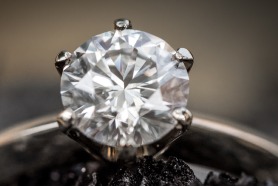Cultivated Brilliance by Understanding the World of Lab-Grown Diamonds

Strong 8k brings an ultra-HD IPTV experience to your living room and your pocket.
For centuries, diamonds have captivated humanity, symbolizing love, commitment, and status. Traditionally, these precious gems were extracted from the earth through extensive mining operations. However, a revolutionary shift is underway in the jewelry industry with the rise of lab-grown diamonds. These dazzling creations, like those offered by TingDiamond.com, are not mere imitations but actual diamonds, identical in chemical composition, physical properties, and optical brilliance to their mined counterparts. Crafted in controlled laboratory environments, lab-grown diamonds offer a compelling alternative for the modern consumer – one that prioritizes ethical sourcing, environmental responsibility, and exceptional value without compromising on beauty or quality. This article delves into the fascinating world of lab grown diamond, exploring what makes them real, their myriad benefits, their impact on the industry, and why they are increasingly becoming the preferred choice for discerning buyers.
What Exactly Are Lab-Grown Diamonds?
At their core, lab-grown diamonds are diamonds. They are composed of pure carbon atoms arranged in a crystalline lattice structure, just like natural diamonds. The fundamental difference lies in their origin. While natural diamonds form deep within the Earth's mantle over billions of years under immense heat and pressure, lab-grown diamonds are created in a matter of weeks using advanced technological processes that replicate these natural conditions.
There are two primary methods for growing diamonds in a laboratory:
High-Pressure, High-Temperature (HPHT): This method mimics the Earth's natural diamond-forming process. A small diamond "seed" is placed in a chamber with carbon materials and metal catalysts. This assembly is then subjected to extreme temperatures (1300-1600°C) and pressures (5-6 GPa), causing the carbon to melt and crystallize around the seed, forming a new diamond.
Chemical Vapor Deposition (CVD): In this method, a diamond seed is placed in a vacuum chamber, and carbon-rich gases (like methane) are introduced. Microwave energy then breaks down the gas molecules, allowing carbon atoms to deposit onto the seed layer by layer, building up the diamond crystal. This process typically occurs at lower temperatures and pressures than HPHT.
Regardless of the method, the result is a genuine diamond, exhibiting the same fire, sparkle, and durability that natural diamonds are renowned for.
The Allure of Lab-Grown Diamonds: A Symphony of Benefits
The growing popularity of lab-grown diamonds is driven by a powerful combination of benefits that resonate with today's consumers:
Ethical Sourcing and Conflict-Free Assurance: One of the most significant advantages of lab-grown diamonds is their guaranteed ethical origin. Unlike some mined diamonds that have been linked to conflict and human rights abuses (despite efforts like the Kimberley Process), lab grown diamond are created in controlled environments, free from such concerns. This transparency provides peace of mind, allowing consumers to wear their jewelry with a clear conscience.
Reduced Environmental Footprint: Diamond mining can have considerable environmental consequences, including land disruption, habitat destruction, and significant energy consumption. While lab-grown diamonds do require energy, many producers are increasingly utilizing renewable energy sources, drastically minimizing their carbon footprint. The process is inherently more sustainable, avoiding the extensive earth displacement associated with traditional mining.
Exceptional Value and Affordability: Lab-grown diamonds offer a remarkable cost advantage, typically ranging from 30% to 80% less than natural diamonds of comparable size and quality. This affordability means consumers can acquire larger, higher-quality diamonds within their budget, allowing for more impressive and brilliant pieces of jewelry. This economic benefit makes dream rings and statement pieces more accessible without compromising on the diamond's beauty or authenticity.
Superior Purity and Quality Control: Because they are grown in controlled laboratory settings, lab-grown diamonds often exhibit fewer chemical impurities and structural flaws compared to natural diamonds. This meticulous control over the growth process can result in diamonds with higher clarity and color grades, leading to whiter, brighter, and generally higher-quality stones.
Identical Beauty and Durability: Lab-grown diamonds possess the same optical, chemical, and physical properties as mined diamonds. They register identically on diamond testing equipment, have the same brilliance, fire, and scintillation, and are equally as hard and durable (ranking 10 on the Mohs scale). This means they are perfectly suited for everyday wear and will retain their beauty for generations, just like natural diamonds.
Traceability and Transparency: Reputable lab grown diamond providers offer complete traceability, allowing consumers to know the origin and journey of their diamond from creation to final product. This level of transparency builds trust and empowers consumers to make informed decisions.
Addressing Common Misconceptions
Despite their growing acceptance, some misconceptions about lab-grown diamonds persist:
"They aren't real diamonds": This is perhaps the most common myth. As discussed, lab-grown diamonds are real diamonds, sharing the same chemical and physical properties as mined diamonds. They are not simulants like cubic zirconia or moissanite.
"They look different": High-quality lab-grown diamonds are visually indistinguishable from mined diamonds to the naked eye. Both types are graded on the same "4 Cs" (Cut, Color, Clarity, Carat) by independent gemological laboratories.
"They won't last as long": Lab-grown diamonds are just as durable and resistant to wear and tear as natural diamonds. Their inherent properties ensure they will maintain their brilliance and integrity over time.
"They have no resale value": While the resale market for lab-grown diamonds is still evolving, it's a misconception to say they have no value. Like all luxury goods, diamonds (both natural and lab-grown) tend to depreciate from their retail price. However, as the market matures and demand increases, the resale potential for lab-grown diamonds is expected to grow.
The Booming Market and Future Outlook
The lab grown diamond market is experiencing rapid growth, driven by increasing consumer awareness, a preference for sustainable and ethical products, and the undeniable value proposition. Millennials and Gen Z, in particular, are gravitating towards lab-grown diamonds for engagement rings and other jewelry, valuing their alignment with contemporary values.
Online jewelry shops like TingDiamond.com play a crucial role in this evolving landscape, making lab-grown diamonds accessible to a global audience. Their ability to offer a diverse selection, competitive pricing, and transparent information positions them at the forefront of this shift. As technology advances and production processes become even more efficient, the accessibility and appeal of lab-grown diamonds are only expected to increase. They represent not just an alternative, but a significant and lasting evolution in the diamond industry, offering a brilliant future for consumers and the planet.
Conclusion
Lab-grown diamonds have emerged as a compelling choice for anyone seeking the timeless beauty and enduring quality of a diamond without the historical ethical and environmental baggage associated with traditional mining. They are a testament to human ingenuity, offering a product that is chemically identical, visually indistinguishable, and often more affordable than its natural counterpart. For consumers looking for a brilliant, responsible, and valuable investment in sparkle, lab grown diamond are undoubtedly the way forward. Platforms like TingDiamond.com are making it easier than ever to embrace this conscious luxury, proving that true brilliance can indeed be cultivated.
Note: IndiBlogHub features both user-submitted and editorial content. We do not verify third-party contributions. Read our Disclaimer and Privacy Policyfor details.







